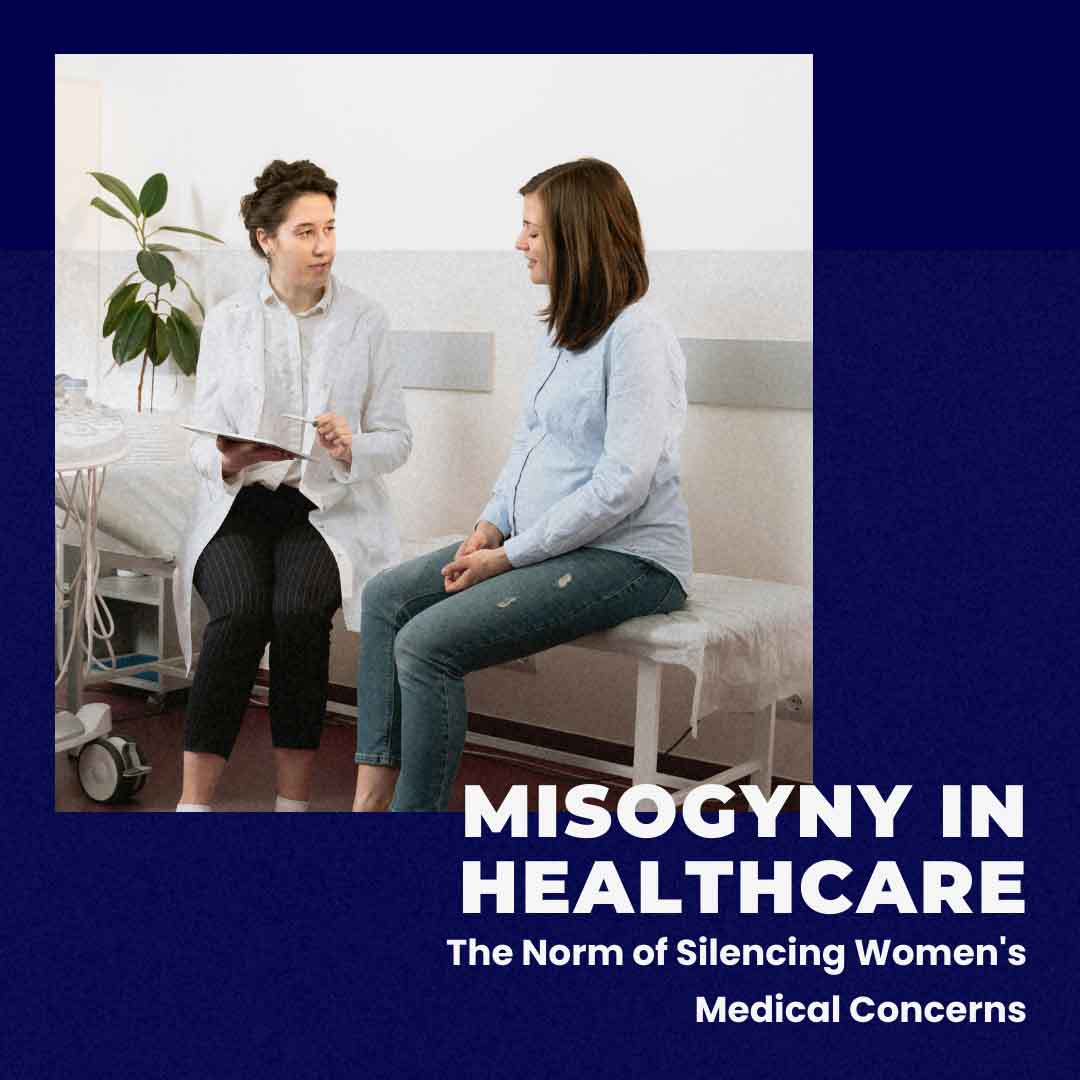Overview:
- Women face misogyny even when they seek medical help.
- There is a pervasive misdiagnosis of women worldwide.
- Stereotypes leaning towards misogyny make medical professionals mistreat women.
- A better healthcare system could be achieved if medical professionals and allies embrace and uphold equality.
“You’re Probably Just Having Anxiety.”
This dismissive phrase becomes increasingly common for girls as they reach adulthood. The changes taking place in one’s body due to the raging of hormones can lead to confusion. Over time, this confusion starts to get accompanied by the uncertainty about their own health.
Surprisingly, facing neglect by medical practitioners is an experience many women go through in their clinical appointments. It is such a common occurrence that a number of countries have conducted studies proving it.
A Danish study shows that women are diagnosed years later than men for the exact same diseases. Another study from Kolkata, India, revealed that breast cancer diagnosis delay in women was caused by delay by physicians. The results of the study were shocking for the doctors who conducted it. This shock was owing to the fact that they had presumed the reason was a lack of awareness among women.
Women of all ages are far more likely to be misdiagnosed or receive delayed diagnoses compared to their male counterparts.
This article explores the prevalence of gender bias in healthcare settings and what could be done to prevent it.

The Dismissing of Women’s Pain
Despite the persistent saying “men don’t feel pain,” it is women who are often expected to tolerate it.To such an extent that some women are even denied anesthesia during procedures that would typically require it for men.
An infamous example is the insertion of foreign solid substances like IUD into the uterus through the cervix. Innumerable women report excruciating pain, even crying and begging the doctor for anesthesia during these procedures.
Unfortunately, this expectation of having to put up with pain doesn’t stop at intrusive procedures itself.
Failure at Seeking Mental Diagnosis
Men are three times more likely to be diagnosed with ADHD than women. This is because women often exhibit milder symptoms that doctors overlook. Research suggests that women find it hard to get a diagnosis because they grow up masking their symptoms. This applies not only to ADHD but also to autism and OCD.

Delayed Diagnosis
Getting a timely diagnosis is essential to manage all forms of human disorders and illnesses. Recognising the nature of an issue empowers individuals to address it effectively. Getting a late diagnosis for cancer results in irreparable losses. Delayed diagnosis for mental issues like ADHD which can lead to secondary problems like eating disorders and depression. The effects of not getting medical care can be drastic but many women end up going through it.
On average, women receive a cancer diagnosis 2.5 years later than men. The diagnosis for metabolic diseases like diabetes come 4.5 years later.
Many women only receive diagnosis when they arrive at the emergency rooms. Some women experience ovarian cysts bursts and ovarian torsion because of delayed diagnoses.

Lack of Research into Female Bodies
Women often face more struggles than men after they seek medical help because practitioners struggle to recognise their symptoms. The reason why doctors fail is the lack of research focused specifically on the female body.
The severity of this research gap becomes clear when considering historical practices. Medical advancements based on testing drugs on mice excluded female subjects entirely.
Recently, studies included women to re-evaluate medications. The results of these inclusive studies revealed significant differences in basic biological processes between the sexes, such as pain processing.
The lack of research on “non ideal subjects” (women) has led to a global issue. Female anatomy, symptoms, and medication responses are often missing from medical records and curriculums. This leaves women to suffer without explanation for their suffering until it’s too late.
Violence against Pregnant Women
Obstetric violence, or violence in the labor room, is a widespread phenomenon which inflicts traumatic experiences to pregnant women. It is a deeply rooted form of abuse present throughout reproductive healthcare, from preconception care to postpartum. From withholding pain relief medications as a supposed training tactic for childbirth pain. To disregard women’s concerns and wants with the stigma that expecting mothers need to stop prioritizing themselves. Obstetric violence manifests itself in many ways.
This violence often results in postpartum depression, physical complications and even death in some cases. It dehumanizes women through practices and behaviors rooted in misogynist expectations.

Reasons for Unequal Healthcare
Having established that women globally face neglect from the flawed healthcare system. It is important to look at the reasons for this gender biased medical neglect. This must be done as recognizing the origin of issues is what will help in uprooting them from society as a whole.
Focus on Fertility
Many women who reach out to the healthcare system for concerns over irregular periods, and unbearable cramps are left frustrated. The cause of this frustration is the failure at receiving a diagnosis or treatment plan. Which is aggravated by prescription of oral contraceptives and the instruction to only reach out when planning pregnancy.
This is the result of a belief that a woman’s health only matters in relation to childbearing. It has resulted in many young girls losing control over their bodies. This convinces them that they must wait to receive proper care. It influences them into believing that they must wait until their bodies become a means of extraction for someone else.
Stereotypes: A Major Root Cause
Women who are complaining about pain are often not taken seriously by doctors due to their ingrained misogynistic biases.
Many concerns of women are dismissed because the doctors perceive the complaining women as overly sensitive or seeking attention. Their outspoken concerns are seen as nothing but a result of gender specific sensitivity to insignificant pain.
Such harmful stereotypes prevent women from receiving adequate information and monitoring of their health. Withholding proper treatment based on stereotypes dehumanizes women and strips them of autonomy and involvement in decision making.
Issues Relating to Self-Perception
Female reproductive issues like PCOS and PCOD cause women to appear and feel less feminine. This fear of being different from others leads to having low confidence. Women may hesitate to speak up due to shame about their own condition. Their reluctance in raising their voice is a result of doubts or denial of their conditions which arise from being constantly questioned.
Lack of Awareness about Symptoms
A study found that women are more than twice as likely to die after a heart attack than men. This high fatality rate in women is a result of lack of knowledge about how their heart attack symptoms are different from mens. This lack of awareness also applies to many other medical issues, such as, cervical cancer, breast cancer and endometriosis.

How to Prevent Misogyny in Healthcare
Women need to unlearn the behavior of constantly doubting their own body signs. They need to let go of the habit of internalizing the dismissive language of others. They have to learn to trust their own voice when speaking to doctors.
A key strategy through which women could get confidence in their voice is by gaining information about their body. Both younger and older generations need education about the medical conditions that affect women. This could be delivered through traditional means of education to coming generations with updated academic materials. Women who have long left educational institutions can be educated with the means of social media. This will help to empower women and will help their loved ones to understand the symptoms that warrant medical attention.
Shame is a big part of silence around physical changes. That is why it is important to foster an environment for women where they can grow up confident. Bringing a change at home can allow such an environment.
To ensure the existence of good doctors, medical schools need to shift their focus from a male-dominated research and medicinal practices based system. They should integrate an educational system that comprehensively addresses women’s health and their bodies.
Funding towards female healthcare and research needs to be the utmost priority. This is to be done to ensure women receive medications which are built for their anatomy.
Conclusion:
The female gender is vulnerable to a plethora of physical conditions. A result of all the changes their bodies go through like pregnancy, menopause and even their monthly cycles. That’s why it’s crucial to prioritize the monitoring of their health without letting biases affect any of it.


